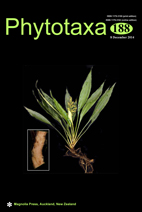Abstract
Recent molecular phylogenetic studies have confirmed that Microlejeunea (Spruce 1884: 286) Stephani (1888: 61) is a good genus which is closely related to Lejeunea Libert (1820: 372) (Dong et al. 2013; Wei 2013). Microlejeunea is distinguished from Lejeunea by the presence of ocelli in the leaf lobe, transverse section of the stem consisting of seven cortical cells and three medullary cells, and keel of the female bract usually winged (Wei & Zhu 2013). Although about 50 species are currently accepted in Microlejeunea, most of them are still poorly known. Microlejeunea subaphanes Herzog (1950: 70) is a very rare species known only from the type specimen collected in São Paulo, Brazil (Herzog 1950; Gradstein & Costa 2003), and its identity is not clear (Bischler et al. 1963). Our examination of its type specimen showed that M. subaphanes does not belong to Micrololejeunea because of the distal hyaline papilla of the leaf lobule, pycnolejeuneoid gynoecial innovation, keel of female bract not winged, transverse section of the stem consisting of 7−9 cortical cells and 4−5 medullary cells, and absence of ocelli in the leaf lobe (Fig. 1). Further critical study revealed that M. subaphanes is conspecific with Cheilolejeunea decursiva (Sande Lacoste 1855: 522) Schuster (1963: 112), which is widespread in tropical Africa and rare in Asia (Borneo, Java, Sri Lanka), Australia and Oceania (Fiji, Hawaii) (Zhu & Lai 2005).

